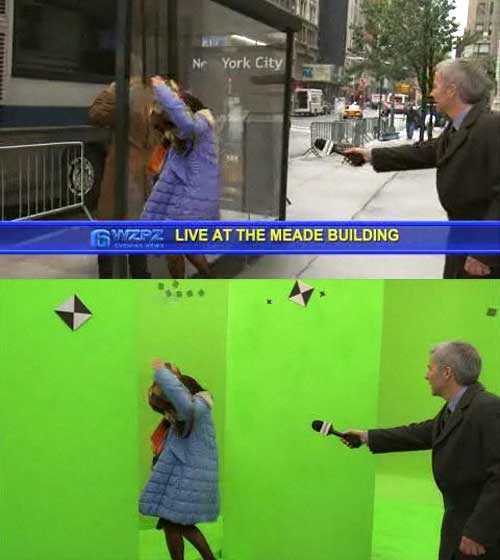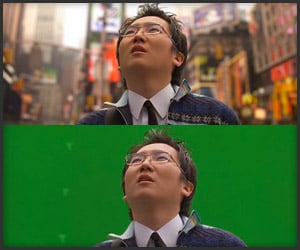Friday, September 30, 2011
Flip Books
Thursday, September 29, 2011
Stargate Studios: Virtual Backlot


Wednesday, September 28, 2011
More on Opening Titles
As noted in class, I decided on recreating the opening for How I Met Your Mother:
As I was watching the sequence on youtube however, I stumbled a few mashups that people created of two different shows, for example the following is credits for Buffy the Vampire Slayer, HIMYM style:
The common denominator between the two shows is obviously Alyson Hannigan, but I thought it was interesting how this person tried to pick characters from Buffy that fit into the roles of characters from HIMYM.
I also noticed that this sequence had a little camera work with the pictures wiggling, but no 3D effects with the camera like the actual HIMYM opening.
Finally, I really enjoyed this HIMYM, Friends style opening. There were quite a few of this combination, but this was by far the best one:
Link to Mocha Download
Tuesday, September 27, 2011
An idea for project #1
It wouldn't let me put the actual video here so this is the link. I like this one because I can use old videos and pictures of my family or friends and fade them together. The hardest part would be figuring out the effects that happen at the beginning and end of the song.
Option two is Gossip Girl. Here is the introduction.
Gossip girl is a lot shorter but I think it looks pretty cool. I have no idea how to make that but I think it would be fun to learn.
These are just two ideas I had and I am hoping one of them may work for me.
Recreation Project Ideas
Project #1 ideas
When you look at each of the elements closely it doesn't seem like their's that much to it. Basically it starts with you flying through space, where i would create glowing stars and planets and try to make them appear to fly by as if the viewer was zooming through. It then zooms into the earth to show dozens, maybe even over a hundred still images. It seems as though you are flying through each image to the next faster and faster as if you were flying through history. Here i think i would take each image and scale animate them so they scale up and cut to each image somehow. The sequence ends with a quick video clip of the cast in present day and then the show's title graphic.
If i am able to figure this out, i was going to replace the historic images with images of me throughout my college years. I haven't thought of a name for it yet.
I have a few backups as well in case this turns out to be to difficult. My next idea was to replicate Heroes. This one is shorter. It's all graphic and animation and no video which could be difficult but it seems pretty simple.
Ideas for the first project
Option One:
The opening title scene of Chuck but I found something really cool on youtube that someone did using supernatural within Chuck's title sequence!
Original:
Supernatural Version:
Option Two:
Community:
Option Three:
Skins:
Skins (British version of course)(can't be embedded)
This is Harry Potter version someone did of the opening!
Then simpler ideas (but really short openings) I was thinking about were Lost or Gossip Girl!
Project #1
My favorite and most realistic was Modern Family. I'm not sure if the length is too short tho.
My second favorite and a little bit more complex would be the Dancing with the Stars intro. I think I could do it, but I'm afraid it would not look as glamorous.
My other favorites were the intros to Saved by the Bell and The Brady Bunch. Both use motion graphics but not as "clean cut and edgy" as they TV is produced now.
Help me decide!
Monday, September 26, 2011
Face replacement
Motion Graphics Project
Obviously, Misfits is very very complicated and I wouldn't even know where to begin! I love the show and I love the animation with the combination of real footage and the text in the beginning but it would just be too difficult for a beginner like me. After a lot of thought I settled on the opening sequence for House.
I think it's a lot simpler and doable, but I could be wrong? I plan to change the opening sequence and call it "Watson" and replace the footage they have with footage from BBC's Sherlock. Let me know what you think!
Web Portfolio Tips
Sunday, September 25, 2011
Use and Overuse of Graphics and Animation in Outdoor Television
Today there are three outdoor channels both on cable and satellite television. The shows on these channels are geared towards outdoorsmen, hunters, fisherman, and people who just plain enjoy being out in wild.
I wanted to write my post this week and show those who don't know about this growing industry in order to show that the same steps go along with producing and finishing one of these shows.
Top companies like Drury Outdoors and Mossy Oak have created their own shows where they go around the world and hunt and fish the many species of out great world. From Kansas all the way to Africa, these teams set out to produce and finish shows that take the audience inside this world. As with any TV series, there is a large chunk of time that is devoted to post production and the need for editors and motion graphics artists is rising. I have found that the shows that have a large financial backing are the ones that use the right amount of graphics, but there are also the shows that don't have employees with production backgrounds
Here are two examples of the good and the bad
Good
Bad
As you can see there are many areas of these short clips that could be changed into quality products that even producers for the Discovery Channel would be proud.
Because this industry is only growing I have found myself very intrigued at the opportunites I could have with knowledge in editing and motion graphics. The need is there and in ten years hopefully this part of the industry will improve and the amount of quality shows and productions will be much higher.
MLB's Strike Zone Technology

Digital Artistry

I had been looking at examples that used human models with graphically designed items around them, but when I saw the thumbnail for this, I figured she had to be designed, as there was nothing else going on in the photo. In my opinion, she looks extremely realistic and seeing her quickly, I would never guess I weren't looking at an unaltered photograph. Upon closer inspection I would critique her hair for looking a bit unnatural in some parts (the whispiness on the right side) and the corners of her mouth. Although not human is perfect, her mouth could be suitable.
With the realistic nature of this CG woman, it makes me wonder if there will ever be a day where human actors are no longer needed. I think that creating movement and action shots for groups of CG humans would take a lot longer than shooting working, tangible people.
I feel this website would be a good place to look for real talent who may wish to freelance their work. As a digital artist, it would be a good place to spread the word about your work and be noticed.
Soul Surfer
After some research online I found that a small company called Engine Room worked on and created all the visual effects for Soul Surfer.
"The visual effects is what made the film," said the movie's director Sean McNamara.
With just 10 employees and nearly 30 outside artists, the company did the lion's share of the 750 visual effects shots in the film for less than $1 million."
"Part of the key to survival, he says, is keeping overhead costs down. The company, which at one point had 40 employees, relies mainly on freelance digital artists who work as independent contractors and are paid a flat rate, rather than by the hour. "It's a very labor intensive business and it's easy to underestimate the costs of labor,'' he says. "It's what sinks companies."
Engine Room also recruits globally through an online registry it launched in 2009 that allows digital artists to post samples of their work. For "Soul Surfer" the company enlisted artists from China to New Zealand and Macedonia, although the bulk of the work was done by freelancers working out of their homes in California, Schmit said."
"During filming, Robb also wore a green sleeve or had her arm painted green, a technique that makes it easier for digital artists to later "remove" her arm when scenes are composited on a computer screen. Once the green arm is removed, however, it leaves behind an empty space. So McNamara had to shoot additional shots of Robb's torso and of background scenes without her in it to fill in the empty spaces.
There was a further complication. Most of the surfing scenes -- captured with cameras mounted on jet skis and surf boards -- were actually performed by Hamilton herself, who acted as her own stunt double. "She said there is 'no one better able to play a one-armed surfer than me,' '' McNamara said.
That introduced another technical challenge for Schmit and his visual effects producer Michael Caplan. Their task was to carefully meld Robb's head onto Hamilton's body, all the more tricky given that Robb was about 9 inches shorter than the 5-foot-11 Hamilton. That was achieved through a combination of digital effects and camera tricks."
- LA Times